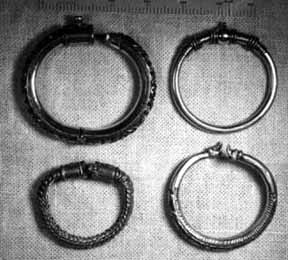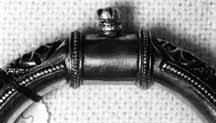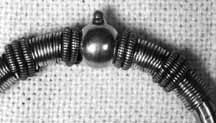Indian silver jewelry
Be different
Galveston Island, January 2012
SILVER JEWELRY FROM INDIA
by George F. Hart
1992
George has bought and sold non-European silver for over 20 years principally
whilst working on a Smithsonian Institution contract in India during the 1980-2000
period. The following article might be useful regarding selecting silver
items.
The sale and evaluation of silver jewelry depends on three levels of interest:
the dealer, the seller, and, the [ultimate] buyer. In silver jewelry the
"silver" is rarely faked as it is so cheap to purchase in bulk, therefore, when
assessing the value of silver jewelry the weight is the first thing taken into
account, as this sets the base price in terms of silver cost. However, whether
an item is new or old often is irrelevant from the dealer-seller viewpoint,
although it is a factor which effects value between the seller and buyer. The
next feature to make a decision about is whether or not the design is pleasing:
for dealers this does not alter the price much as it is a yes or no answer that
depends on the seller. Unusual designs can up the price, but again this depends
on the taste of the seller. However, if the design is unique or rare then the
price increases: often dramatically. The question of workmanship is the final,
and perhaps the most important thing to consider. Workmanship, particularly if
it is by a known artist, can 'sky-rocket' the price.
The status of silver, like that of gold, is connected primarily with its rarity
and only secondarily with its embellishments. Wealth was at one time, and is
even today in some societies, hoarded in the form of precious metals and gems.
In some cases these are constantly worn, as the best means of retaining
possession. Traditionally, the basic ornament of a long string of beads of
precious metal and gemstones is simply the stringing of wealth around the neck
to keep it safe.
Not until the arrival of the British in India did silver become more prominent
as the metal of the jeweler. The industrial era brought with it less need to
carry one's treasure on one's person, and except in rural areas, jewelry became
light in weight and bulk, and the use of metals regarded as less precious than
gold [white gold, platinum and silver] came into vogue. Silver jewelry is more
reminiscent of rural communities and ordinary villages, whereas gold was worn by
the family of chiefs and wealthy landholders.
Traditional Methods of Fashioning
Next to gold, silver is the most malleable and ductile of all metals. The
jewelry is fashioned even today with traditional iron, copper and bronze tools.
In rupousse work, a design is
punched into relief from the back. The sheet is then engraved and chased on its
front. Chasing is making an
indentation into the silver by pressure, whereas engraving gouges out the metal. The resultant sheet is then
worked into its final design. Open
work is produced by cutting the sheet metal with a saw. Die stamping sandwiches the sheet metal
between a metal pattern mold and a lead sheet, whereupon it is beaten with a
mallet. Filigree work is silver
wire that has been shaped by tweezers. The attachment of round balls of metal by
gluing and then blow-piping is called rawal. Traditionally, when gemstones were incorporated into the
jewelry they were left uncut. The use of claw settings to hold cut stones came to India with the British.
Fakes and Forgeries
Silver jewelry can be classified into six categories according to age:
archaeological, historic, antique, vintage, modern, and contemporary.
Unfortunately, there is no sound scientific method of dating metals comparable
to the use of radiogenic carbon for organic materials and thermo luminescence
for ceramics. Style and technique are used to determine the approximate age of
an unknown piece. For this reason there are some master forgers among modern
Indian craftsmen who produce imitations and reproductions of antique, historic
and archaeological pieces. The problem of silver content is not normally an
issue as it is with gold, primarily because of the relatively low cost of pure
silver. In general one must rely on the knowledge and honesty of the dealer to
know the age. Because much of the antique and historic silver jewelry produced
in India was made from old coinage, it is possible to determine the age of the
silver that was used to make the jewelry by comparing the detailed chemical
analysis of the piece with a reference set of chemical analyses from silver
coins. However, sometimes the silver is used over and over again so that it is
possible to have a contemporary piece made from silver coinage that is antique
silver. Historic and archaeological silver regularly contains lead isotopes and
these can be used to provide some information about the source of the metal. But
silver decomposes when buried. So it is only under unusual circumstances that
artifacts made of silver are preserved in archaeological sites.
The Silver Minerals
Although silver can occur in nature in a free state that is 99% pure, it is
generally mixed with copper, gold and other metals. Most silver is obtained from
smelting of some mineral ore in which the actual silver content might be very
small. There are two major groups of ores from which silver is produced. The dry
ores are the true silver ores and mined primarily for their silver content. The
metalliferous ores are ores of some other mineral, such as lead, zinc and
copper, in which the silver is produced as a bi-product. Refined silver contains
between 997.5 and 999.0 parts per 1,000 of elemental silver. A standard troy
ounce is 925 fine, which is derived from the silver content of the older British
coinage.
Ancient Sources of Silver
Traditionally, India does not produce silver, yet silver jewelry is everywhere.
The modern silversmiths can purchase silver as a bulk commodity, but the earlier
artisans obtained their material by trade, principally with northern neighbors.
Armenia, Persia and Afghanistan were important sources of silver for the Indian
silversmith. Coinage was introduced into the subcontinent by the Persians, and,
after the Persian emperor Darius I annexed north-east India in 518 BC, Persian
coins became the dominant source of silver for Indian artisans. The white Hun
overran the region in 455 AD. producing a period of cultural blight not to be
changed until the coming of Islam via Mohammed-bin-Qasim, the Damascene general
whose army invaded the Lower Indus valley in 712 AD. A tremendous amount of
silver came into India from Mecca, which Muslim pilgrims must visit during their
lifetime. The old markets of Saudi Arabia were a treasure-trove of vintage and
antique silver jewelry because many pilgrims sold their jewelry in order to have
money for their return trip to their homeland. From the Mecca markets the silver
made its way east and south to northern India, where it became part of the
general pool.
When the Europeans entered India in the seventeenth century they did so as
traders within a well established commercial economy. Bengal already was a
merchant center and the Europeans enhanced this with trade routes to Indonesia
and Europe. However, there was little that Europe had to provide Bengal in
return for the goods they received and a consequence was that Bengal became a
major importer of silver by way of exchange-of-goods. The East India Company
"fairly consistently sent upward of 200,000 (English pounds) a year in silver to
pay for its imports from India. The Dutch imported at a slightly higher level,
and the French slightly lower" [Gordon Johnson, Cultural Atlas of India, Facts
On File, Inc.]
The ancient trade routes, too, supplied their share of silver, principally in
the form of jewelry. Even today it is possible to find material from ancient
Persia, Iraq and the general area of Asia Minor in India. From the north, Tibet,
and even China, trade was established and silver changed hands, gradually
becoming part of the flow southwards. Today much of the tribal jewelry in
northeastern India shows the influence of the Tibetan craftsmen in its use of
green turquoise and silver in combination. It has even been suggested that the
silver art of the native American is derived from the knowledge of the ancient
Asian silversmiths whose wares and techniques were taken first to Spain and then
to the New World.

ITEMS FOR SALE
All jewelry has a 1 month money-back guarentee.
Our jewelry is hand crafted and purchased from antiqarians with whom we
have traded for almost two decades. The pieces represent the work of
silversmiths following traditional ethnic designs.
VINTAGE SILVER NECKLACES
A traditional tribal silver necklace from Rajathstan: with a central silver pendant.
Weight: 113 gms. Price: $250
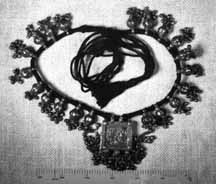
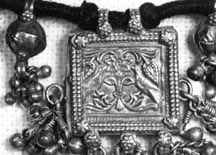
An articulated antique Rajathstan silver choker necklace with an inserted green stone [glass?]. The stone is cracked but whole.
Weight: 186 gms. Price: sold.
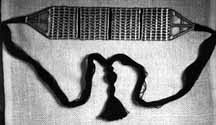
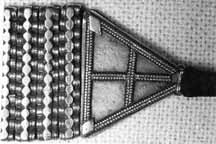
This stunning piece is a silver choker necklace from Himachal and has included British India coins.
Weight: 181 gms. Price $450.
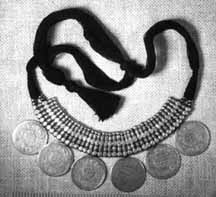
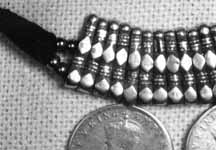
A traditional Gujarat tribal silver necklace.
Price $200.
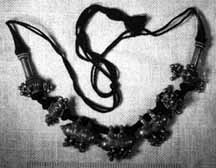
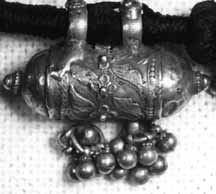
A vintage snake-chain silver necklaace from Mysore: excellent condition and can be worn by a man or a woman.
Weight: 247 gms. Price: $450.
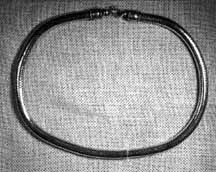
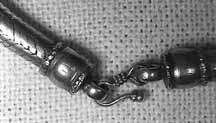
A northern Indian silver necklace formed from ancient Persian coins. This is the best piece in our collection: in an old presentation case.
Weight: 235 gms. Price $800. Sold.
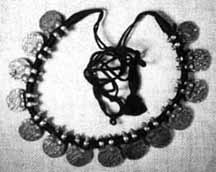
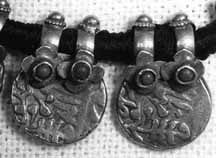
A Kijria Khond tribal silver choker from Orissa: inset with semi-precious stones.
Price: $200.
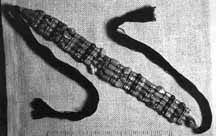
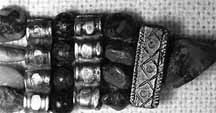
Silver Rajathstan: three silver pendants strung as a choker or necklace.
Weight: 44 gms. Price: $150
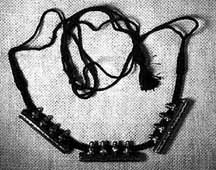

VINTAGE SILVER BRACELETS
A very impressive, massive pair of bracelets. These look stunning on a tall slender person.
Price: $600 for the pair
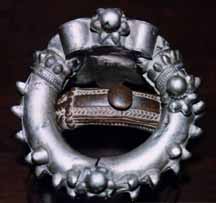
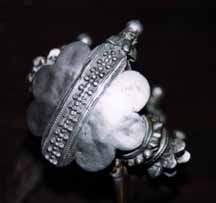
Bracelet silver Antique articulated bracelet: please supply your wrist size in inches
Price: $350.
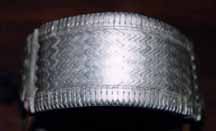
Silver antique Muslim bracelet from Hyderabad with inset [Persian] coins.
Weight:139 gms. Price: $450.
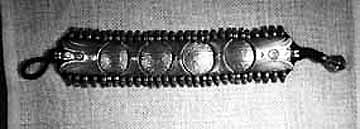
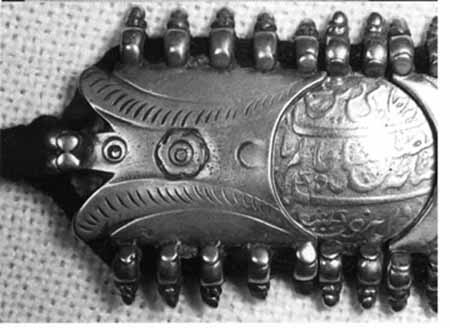
A broad articulating antique silver bracelet. A very stunning piece in a traditional design.
Price: $600.
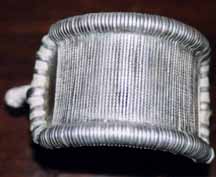
A very elegant antique articulating silver bracelet from Northern India.
Price: $400.

Inexpensive modern silver bracelet from Mangalore
Weight: gms. Price: $40.

Inexpensive modern silver bracelet from Mangalore.
Price: $50.

Semi-precious, color contrasting modern bracelet.
Price: $80.

Modern silver bracelets from Chennai [Madras].
Price: $30 each [a, b, c, d].
